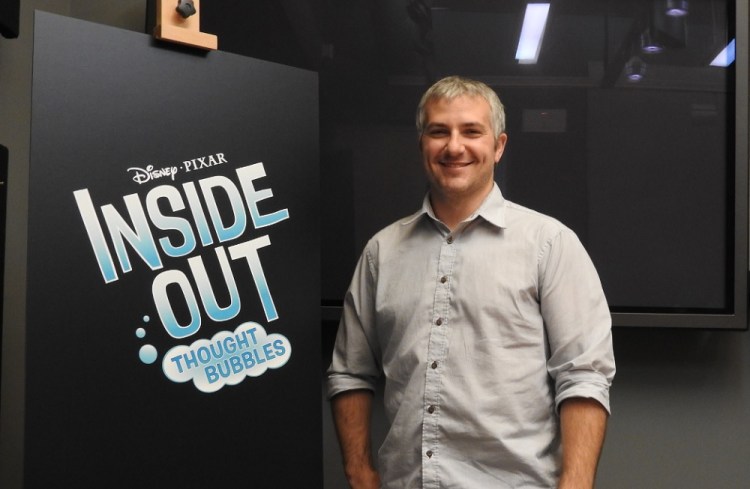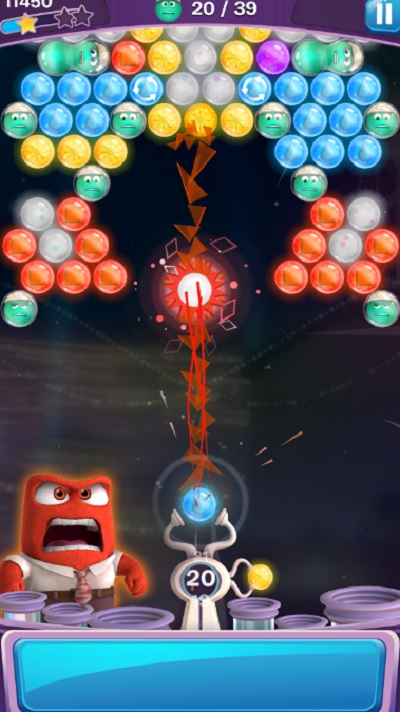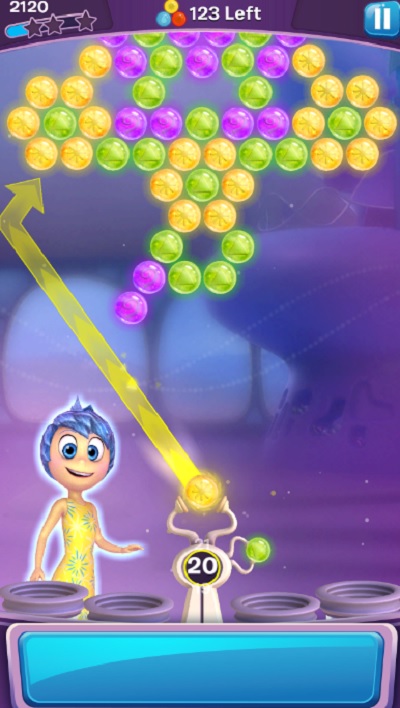When Pixar’s newest film, Inside Out, came to fruition, the teams at Disney knew they wanted to create a mobile game, among other ancillary content, to go with it. But it wasn’t obvious how to take a cerebral and emotional film like Inside Out, which is about the emotions that go on inside a young girl’s head as her family moves from Minnesota to San Francisco, into a game.
The movie takes abstract concepts like emotions and turns them into characters like Joy, Sadness, Anger, Disgust, and Fear. They each have a different color, and when something happens to the main character, Riley Anderson, she forms a permanent memory. Inside her head, that memory takes the shape of a big glass marble with a color, associated with the emotion that dominates it, such as gold for Joy or blue for Sadness. The idea of taking that little ball and turning it into an orb in a bubble shooter game became the basis of the mobile game.
We talked with Tim FitzRandolph, vice president of creative at Disney Mobile, after a screening of the film at Pixar’s headquarters in Emeryville, Calif. He told us how the process worked of hearing about the film and translating it into a mobile game, Inside Out: Thought Bubbles, which debuts on mobile devices today.
Here’s an edited transcript of our conversation.
GamesBeat: When did you get started on the mobile game?
Tim FitzRandolph: We first got a chance to see what was the film at that point about a year and a half ago. We spent a few months deciding what we’d make, making prototypes. The game itself took about a year to make.
GamesBeat: The movie itself probably didn’t change too much?
FitzRandolph: It depends from movie to movie. Some do change a lot during that duration. This one didn’t, very much. The first time we saw it, it was just a storyboard. But most of the story, the main story, was what you saw today. Just a few changes with regard to the tone of the movie – how much humor, how many emotional strings to pull, that kind of thing. It was great, because we knew exactly what the movie was going to be. We had a nice target to shoot for.
GamesBeat: How soon did you think of the bubble comparison to some of the things in the movie, like the little memory balls?
FitzRandolph: It seems super obvious, but it wasn’t immediate. We saw the screening and we were absolutely convinced that this was an amazing movie. It was going to be a general-audience, kids-to-adults appealing movie, which was perfect for us making casual games. We knew there was a great fit. But we were so impressed with the world they had created that we wanted to come up with something that would evoke all the stuff in the world. Some of the more obvious game genres didn’t seem to allow for that.
We tried a bunch of stuff. We prototyped tons of different ideas. One of our prototypes that survived the longest was a solitaire card game. We had these cards that represented the different emotions. We’d come up with a rule set that tried to evoke what it’s like in Headquarters when they’re dealing with different scenarios. We were pretty happy with that game. We felt like the themes of the movie were well-represented in the gameplay. But the more we played with it, the more we realized we were straying from our goal of making an accessible and simple game people would be able to pick up and enjoy across a wide age range.
We went back to the drawing board, and that’s when we were looking back at the materials, looking at the memory orbs. We thought, “These are definitely gameplay objects somehow. They’re primed for it.” The film has taken such an abstract concept and turned it into a physical space with physical rules that apply to them. A memory becomes an orb and goes down this way and over there. The physicality of it, the orbs clinking together and everything, led us to—“Wait a minute, they’re color-coded, too!” We had this game type that we all love. We’ve played it in the arcades and on PC and on modern platforms.
GamesBeat: The other possibility would be match-3, it seems like.
Fitzrandolph: Match-three could work. We did prototype match-3s. But when we talked about the bubble shooter, Bust-A-Move genre, the main difference was that it’s more physical. The ball travels and bounces and sticks where it hits. It’s a more analog, physical implementation, whereas a match-three game on a grid is more abstract. There isn’t any real physical rule that applies.
GamesBeat: Another one for you: pinball.
FitzRandolph: This game is sort of the simple, accessible parts from a match-three game, but with the physicality of pool or pinball, where you’re thinking about rebounding. Can the ball fit through there? There’s a skill element to it that’s nice. You can make a good shot or you can screw up a shot, which is a nice balance for a game.
GamesBeat: Did you ever consider doing multiple games, or did you always want to do just one?
FitzRandolph: We definitely wanted to focus on one, both for practical reasons and also just because our goal is to make—our games on mobile, we update and support them continuously. We treat them like a service. Landing on one that was a fertile game that we felt could continue to be interesting and have variety that lasts for a long time was important to us. The genre fits well with that. We can continually add new goals, new gimmicks in the levels that are pulled out from the movie. We have a lot of natural connections there. It felt like a good fit.
GamesBeat: Does it weave the movie’s story into it?
FitzRandolph: It’s very light. I feel like this is not the best screen to be telling a story on. Not to mention that the method of interaction is short and spread out. Rather than even attempt to do any kind of justice to the story we were so inspired by, we decided to focus more on letting you spend more time in the world. That’s why the map takes you on a loose journey through the locations of the film, but mostly as a way of letting you understand your progression. “If I get to that next island there will be something new in the game, some new element introduced.” Those elements are inspired more by the world and the locations and the rules and the imaginative conceit than the plot.
What story there is, it’s mostly the micro-story of an individual level. I wouldn’t even really call it a “Story” with a capital S. It’s much more light. We have a level where the mind workers, those characters who are deciding what to forget, are trapped in the level. You need to free all seven mind workers. There’s a light story – you’re down there in the world of the mind and you’re helping sort the memories that accumulate from the day, and also help the characters you remember from the film. But in a very simple, straightforward way that we think fits the platform.
GamesBeat: Had you guys done this kind of bubble shooter game before?
FitzRandolph: No. This was the team’s first one. We had to create the framework from scratch. We went and re-acclimated ourselves with all the classics, to remind ourselves what was great about them. We also wanted to understand the challenges of a different input scheme. It works out pretty well, though, because you can touch anywhere on the screen. Aiming is quite intuitive.
The biggest challenge we had is that some people would assume they needed to touch up above, while other people would assume it’s more Angry Birds style where you touch below.
GamesBeat: The first thing I did was try to slingshot.
FitzRandolph: Right. That’s become a mobile shorthand. You can drag your finger down below, and then we just have reversed aiming as if we’re drawing through the launcher in the direction you’re going to go. We support either one. That’s one thing about our process–It’s kind of like how Pixar has reviews where they show the film, gather feedback, repeat, repeat. We do the same thing with our team, where we do creative reviews. We have our designers who aren’t working on the game give feedback. We also do tons of playtesting and observe how players interact with it – what’s working, what’s not. Then we can improve based on what we’ve learned.
GamesBeat: Is the release the same time as the movie?
FitzRandolph: Yeah, it’s the same day. The evening of that Thursday.
GamesBeat: So that you’re able to benefit from all of the marketing happening everywhere.
FitzRandolph: Yeah. In the theater, before the movie, we’ll be in the preroll thing. The game trailer will show in the film trailers. Hopefully, people will download it while they’re waiting.
GamesBeat: Is it a paid beta?
FitzRandolph: No, it’s free. You can play the whole game for free, but it has the standard elements you’d expect that you can choose to pay for, or be persistent and patient.
GamesBeat: Have you guys done a day-and-date movie game before?
FitzRandolph: Cinderella I think was the first one? We did a similar thing with that one where we had the trailer in the theaters. That seemed to work pretty well. I’m psyched that we get to do it for this game.
GamesBeat: It does sound like you had quite a bit of time.
FitzRandolph: We did, yeah. That was nice. These games are simple, but complex at the same time. We wanted to push the quality, particularly in the characters. Hopefully it showed through in the demo, that we put a lot of effort into making the characters look true to the film and be very expressive. They’re the main link back to the film. We spent a lot of time on that. And there’s a ton of levels, of course.
GamesBeat: The Infinity folks sound as if they worked a little longer than you guys.
FitzRandolph: Yeah, I think they had a bit more time. I’m not completely sure. I believe they got to see the film even before we did.
GamesBeat: Is it usually that year-and-a-half lead-up where you get your first look?
FitzRandolph: We get different tiers. We get a chance to see or hear extremely rough pitches of things that are coming a couple of years out. That’s usually too long. We don’t want to spend that much time on something. The market moves so fast and the games don’t need that much time – at least the mobile games. It’s pretty nice, really.
We’re not quite like a console game. There’s that classic story that console games and movies take about the same amount of time to make, so there’s this chicken and egg problem as far as waiting for the movie to solidify, but then it’s too late to make a good game. We have less of an issue with that because the games don’t take quite so long. A year is a bit on the long side for us, but it was a kind of game we hadn’t made before, so that’s why we took the extra time.
GamesBeat: In the context of this year, brands are popular in mobile games. I wonder how you guys think about that. How do you say, “OK, we know we’re going to do this, but how do we do it in a way that’s not exploitative?”
FitzRandolph: It’s a concern for everyone, and not just because we take pride in what we make. You see the other products out there. If there are a lot of products that are relying mostly on their association with a brand, it makes the whole market feel like—Any time you see a heavily branded thing, is it one of those?
The main thing for our team was, we’re in an internal team. We all wanted to work at Disney and got to work at Disney. We have a little bit of a different caliber with which we regard the brand. We’re so excited to be a part of it. That shows through in the level of quality in the game. That’s the main thing we can do to combat that concern or expectation. We just do our best to make the level of quality as high as possible, to show some care and attention to the film. The reaction we’ve had from Pixar is good. They felt they were on the right side of that equation. We’re proud of that.
VentureBeat's mission is to be a digital town square for technical decision-makers to gain knowledge about transformative enterprise technology and transact. Learn More






